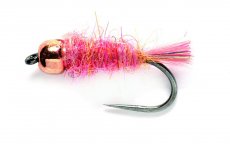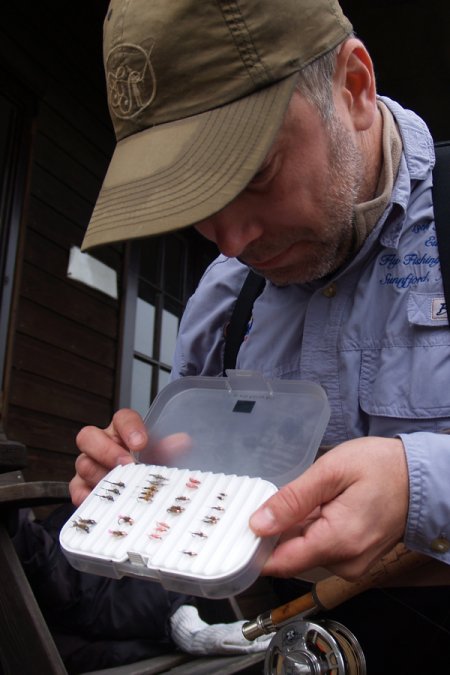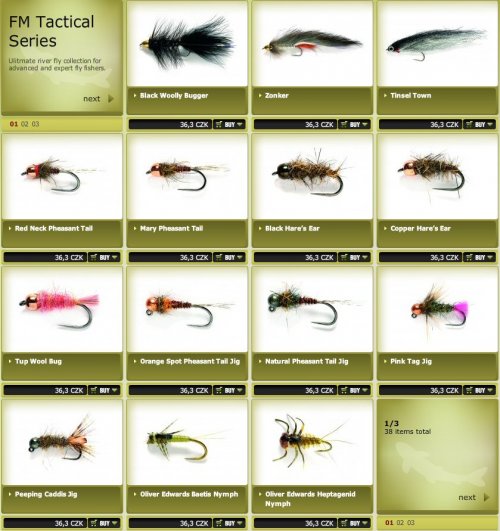Testing results of the Tactical Series - the barbless river fly collection from Fulling Mill.
During 2010, the English firm Fulling Mill introduced to market a new collection of flies for river fishing, under the name Tactical Series. You may say "so what" - but if you are interested in fly-fishing Europe's rivers and streams, I recommend that you don't ignore this. There are many companies producing flies, and the number of patterns runs to the thousands. The average fly fisher can easily get lost in all the choices. What are all these patterns good for, when most fly fishers only use a few dozen tried and true flies?
Why then should we get excited about the Fulling Mill Tactical Series? The arguments are simple:
- It's a selected collection of 28 modern patterns for all types of river fly fishing (dry and wet flies, nymphing, streamers)
- They were selected by premier English fly fishers including Oliver Edwards and Jeremy Lucas.
- The collection also contains effective tungsten nymph and jig patterns which are not currently commonly available, as well as realistic patterns according to Oliver Edwards, which are a major challenge for regular fly tiers
- All flies are designed for sport fishing and are therefore tied on barbless hooks
The Tactical Series collection covers most needs of the European river fly fisher, and each of us will likely find new patterns to compare with those in his/her fly box. What caught my attention first were the tungsten jig flies. I have long practiced nymphing (both Czech and French styles) and know from my own experience how difficult it is to obtain quality commercial tungsten nymphs and nymphs on special jig hooks - exactly those patterns I see my competition-level friends using at the world-class level. The Tactical Series has changed that. Now all fly fishers have the opportunity to fish with patterns which have up to now been hidden in the fly boxes of the best European fishers.
Despite the fact that I was sure that the flies from the Tactical Series would work, I couldn't pass up the opportunity to give them an intense test. I got in touch with the former Czech national squad member Dan Svrček, who incidentally was around at the beginnings of jig hooks and experiments with tungsten jigs (at the 2004 World Championships in Slovakia), and we decided to test out the tungsten flies of the Tactical Series in practice.
Dan originally suggested doing the test at his home river of Jizera (in the Giant Mountains of the Czech Republic), but we quickly abandoned this idea - it wouldn't have been very objective, since Dan knows every millimeter of the Jizera and could catch fish there on a bare hook! Thanks to John Wolstenholm at Fulling Mill, we arranged to do the test on a river neither Dan nor I had fished, the name of which lends itself naturally to such a test - the River Test in England.
Surely most readers know of the River Test from paintings or photographs, with English gentlemen catching huge trout on dry flies cast upstream. The River Test is probably the best-known chalk stream in the world, with a long history and tradition, and fishing this river is certainly the dream of many fly fishers. Our mini-expedition to the Test happened in mid-November, which in England is generally thought of as winter grayling season. In addition to the dry flies which rule this season, nymphs can also be fished. We came to England appropriately decked-out, with our fishing tackle stocked with all that is needed for modern nymph fishing - light three-weight rods, nine-meter long Kamoufil nymphing leaders, special strike indicators, and fine tippets for light nymphing. We only left our fly boxes at home, since John supplied us each with a set of flies for testing.
Dan saw the Tactical Series flies for the first time at the River Test, and since he's a skillful tier and former competitor who doesn't normally fish with commercial flies, I was a bit worried about his initial reaction, which tends to be pretty critical. After a first look at the flies and a bit of thought, Dan commented "They don't look bad, though personally I'd make them a little more wild (author's note: meaning more brightly colored), but we'll see". After this comment, I wasn't surprised that he picked out the wildest fly from the box (the Pink Tag Jig), which he tied at the point with a rather more decent Orange Spot Pheasant Tail Jig on the dropper.
What happened next is hard to describe. Those who have fished the Test certainly know the quality of the local grayling and trout and can imagine what such a river can do to the psychology of a fly fisher. It was extremely difficult to keep Dan focused on the test, and me at the camera, since we both caught a massive case of fishing fever. Our main target was grayling, but it was impossible to avoid catching grand brown trout and even occasional rainbows on our nymphs. Trout over 50 cm long were a great test of our fishing skills, as wells as our tackle and the flies.
We were extremely satisfied with the tungsten nymph flies. The shapes, sizes, weighting, coloring and quality of the barbless hooks proved absolutely top-notch. We got the best results from nymphing with two flies (a jig fly on the point, and either a nymph with tungsten head or any other weighted nymph on the dropper). The fly that Dan picked first (the Pink Tag Jig) turned out to be the most successful in the conditions we faced, though we agreed that for other conditions more natural patterns would be better. As usual for grayling, pink patterns on the dropper proved themselves (Tup Wool Bug, Dirty Pink Shrimp).
Two days on the River Test presented us with standard English weather - everything up to and including snow. Nymphing was much more successful when cloudy and rainy, so on the second day, when the sun came out, dry flies also came out of our test boxes. In most cases these were subtle small flies (Barry's Red Tag, Jeremy's Mole F Fly, the parachutes Black Magic Klink or Jeremy's Oppo Parachute), where need appropriate tackle for ideal presentation - light AFTMA 2-4 rods and fine tippets (9X - 7X). To our surprise, Dan found out during this second day that fish also reacted to large skating caddis (Balloon Sedgehammer, Retirer Sedge). This seemed a bit strange to us considering the time of year, but the fish clearly were of a different opinion.
So what was the final verdict from our test of the Tactical Series flies? The flies we used are visually perfect and certainly fulfill the demanding criteria of modern patterns suitable for fly fishing. We consider the Tactical Series to be ideal for fly fishers who prefer fishing with lighter tackle and who support or practice catch & release. There's no need to worry about the barbless hooks, as our experience showed that with a well-designed hook the "loss" of fish is no different than with barbed. Even small flies held fast during the strikes and landing of even large half-meter fish.
In conclusion, I add a short tale of our evening discussion about fly fishing. While sharing our experiences, Dan got his tying vice ready, looked over his tying materials, and immediately pulled out some dark pink thread. It was clear that Dan was going to continue tying his own flies. "What are you going to tie?" I asked. "You'll see" was the curt answer. And after a few minutes, Dan proudly displayed his fly - "Svrcek's copy of the Pink Tag Jig", he announced with a sly smile. So the Tactical Series left its mark even on him...
Full assortment of Fulling Mill Tactical Series available in our eShop.

























